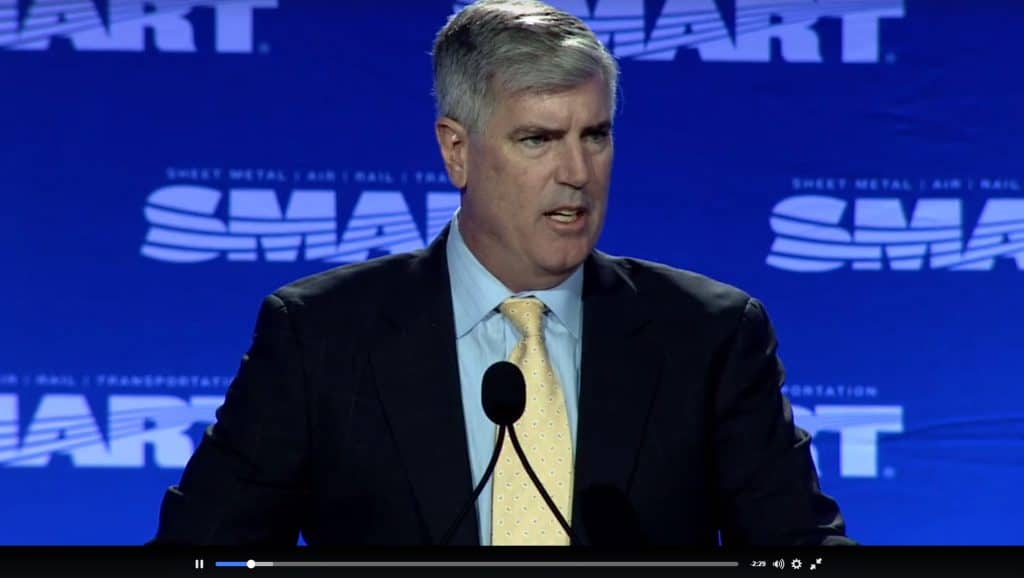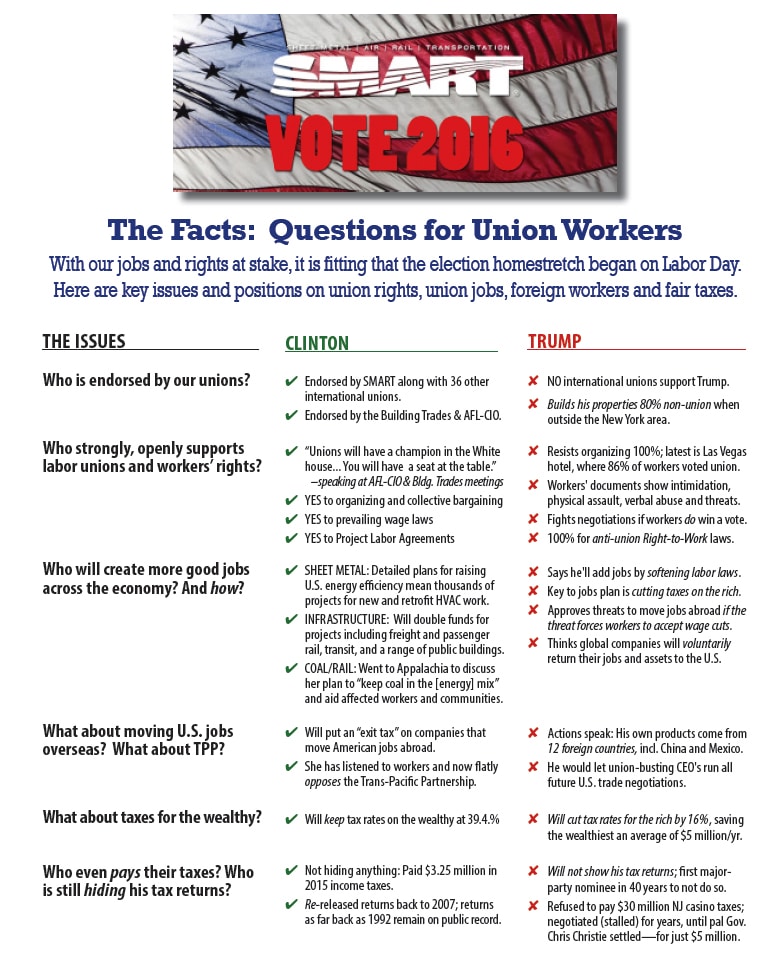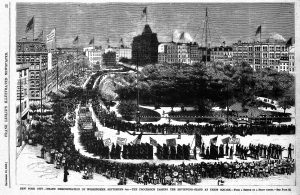We are one month out from election day. Now is the time to get involved. Visit www.SMARTVote2016.org to sign up or text SMART to 90975 (message and data rates may apply). Click on image to play the video.
Author: paul
With Hurricane Matthew already having cost destruction and loss of life within the Caribbean, we urge all members in its path to prepare themselves for its eventual arrival. Visit www.Ready.gov for more information.
Seattle’s Sheet Metal Local 66 has a new leadership development program which has passionately embraced the concept of trade unionism.
The journeywomen have taken the initiative to build a support network for all working women throughout the Seattle Local Union, having committed to mentor the 41 female apprentices in the current 400-member class of five-year apprentices.
Business Manager Tim Carter opened the training by outlining the importance of the program on the first day, saying “The deeper we dig into the topic of women’s rights in the workplace, the more we realize that mentoring programs for our female apprentices are long overdue; they will serve as a safe place for our female apprentices to share situations with their mentors, which will help our Business Representatives find resolutions for the issues our Sisters are facing.”
Connie Ashbrook, Executive Director of Oregon Tradeswomen Inc., a nonprofit organization dedicated to promoting success for women in the trades, and her Advocacy Program Manager, Tiffany Thompson, led a training session on the unique problems women in the trades face, including sexual discrimination and harassment.
The session touched on identifying, addressing and eliminating harassment and on the ability to identify behaviors that indicate harassment and discrimination beyond what is legally defined.
JATC Trustee and Women’s Committee Champion Vanessa Carman has been a key architect in setting this initiative in motion.
“I feel that providing a support system for our Sisters will have a huge impact on retaining our female membership,” Carman said. “Beyond that, there are many other benefits to having a mentorship program: providing support, morale, diversity and pride as well as building confidence in our future leadership.”
SMART Education Director Chris Carlough led a discussion centering around the development of mentoring and peer programs, helping the local union adopt the type of program they were going to build.
“This is more than just a class highlighting the serious issue of sexual harassment,” Carlough explained. “We are building a network of compassionate union members—both women and men—to encourage and support all of our members in their work and family life.”
“The long term goals of this program will include how to change the culture of our union to end bullying and harassment—which will make our workplaces safer, more productive and just a more decent place to work.” Carlough added.
With “work cut out for us,” members up to challenge
“I left the two days of training feeling a wide range of emotions, but most of all I felt hopeful that things will change now that our union is fully aware of the harassing environment on jobsites,” said SM Local 66 shop foreman Martha Holly.
Holly added, “Change will not happen overnight; we all know that. In the future I hope all women in our trade feel supported enough by our women’s committee to have the courage to say, Enough! We deserve to work in a respectful workplace. The women of Local 66 have our work cut out for us, but we are all up to the challenge!”
Fresh from the vice presidential debate, Democratic candidate and Virginia senator Tim Kaine spoke at a rally at Local 19 in Philadelphia where he spoke about his and Hillary Clinton’s economic vision for America.
Speaking about Donald Trump’s possible failure to pay taxes like other Americans, Kaine noted that it “makes me very, very angry” since he knows first-hand with his own son currently serving in the Marine Corps the sacrifices that American troops make and the support Trump denies them.
Referring to the $916 million loss Trump claimed on his 1995 taxes, Kaine noted “I guess it takes a lot of genius to lose a billion dollars.” He asked if “this is the kind of genius you want running the whole American economy? You got to be kidding me.”
Motivating the standing room only crowd of union members and Philadelphia activists, the son of a union iron worker reflected that “It’s close. Just eight days ago it was even. It looks pretty good now, but I’m not sure what’s going to happen in the next eight days.”
“In every election, I put this thought in the back of my head — that I’m the underdog until I win it,” Kaine said. “That’s how you have to run every race.”

Text SMART to 90975 to download the SMART Union app or click here to download the app via the web.
A new Gallup poll shows 52% of Americans believe labor unions benefit the broader U.S. economy, while only 41% believe unions hurt the economy. Although that is still below the historical norm, this it is the most positive Americans have been about unions in a decade and reflects a turning away from the onslaught of anti-union news and propaganda elicited by heavily financed billionaire backed groups seen in recent years.
This represents a 7-point rise since 2011 and it is the most positive Americans have been about the economic effects of unions since before the Bush Administration’s Great Recession of 2007.
In addition, seventy percent of respondents reported back that think unions help members of the union and 55 percent believe they are a positive contributor to companies where workers are unionized.
While Union membership has been on the decline for decades, a recent study by the Economic Policy Institute (EPI) linked wage stagnation during that period to that decline:
According to the Economic Policy Institute study, union membership among men in the private sector dropped from 34 percent in 1979 to just 10 percent in 2013. Among women, unionization has dropped from 16 to 6 percent in the same time period. A study released on Tuesday by the EPI points to declining union membership as one cause of wage stagnation among all Americans.
Click here for the Gallup poll.
The New York City Central Labor Union held the first Labor Day on September 5, 1882—exactly 134 years before this year’s holiday. Then as now, it is a day for enjoyment and for reflection, for remembering the struggles of the past and recommitting to our own work of today and tomorrow.
The power of organized Labor—of the millions of men, women, and families who unite to win respect in the workplace—is never more visible than in these national elections. We have a long history of effective political action, but now it’s time to raise the bar.
After decades of anti-union greed and assault by radical conservatives, our issues–workers’ issues—are once again at the forefront of our national agenda. We have a bipartisan group of candidates—for President, Senate, Governor, and other offices—who openly support unions and union jobs. We should return that support with boots on the ground and with every vote we can deliver.
In 1882, those first Labor Day planners called for a parade and festivities. What stands out is their stated goal: to demonstrate “the strength and esprit de corps of the trade and labor organizations.”
Election season is our time to recommit to fully and clearly demonstrating our strength and union spirit.
From September 5 to November 8, each of us should commit to applying the collective power of 202,000 SMART households. We should put in our time, our energy, and our ballots—along with millions of other union families across America—to support those who support workers, our issues, and our rights.
Let us celebrate Labor Day 2016 in the best possible way: by raising the bar on our efforts to elect candidates who support working-family values—union values.
Joseph Sellers, Jr.
General President
The U.S. Court of Appeals for the Seventh Circuit has found that Unions have the First Amendment right to display an inflatable rat as part of an area standards campaign. Furthermore, localities that attempt to prohibit the use of inflatable rats may be infringing on that First Amendment right.
The decision was made in Laborers Local Union No. 330 v. Town of Grand Chute. The case overturned a lower court decision which originally dismissed the Union’s First Amendment claims. The Town of Grand Chute in Illinois had ordered the LIUNA local to remove an inflatable rat that was being used as part of an area standards campaign. Though the rat was located on a public right-of-way next to the construction project the town still acted to remove the inflatable after the owner of the construction site called to complain.
The Union took the matter to Federal Court claiming a violation of the First Amendment right to engage in free speech. The Union noted that Grand Chute had never enforced its own sign ordinance against other signs around town or even against the rat prior to the property owners complaint. A lower court had originally dismissed the Union’s complaint, arguing that the sign ordinance existed to protect local aesthetics. The Federal Court found that the Union’s free speech was in fact violated due to inconsistent enforcement of the town ordiance and ordered the case be returned back to the District Court with a list of detailed instruction on how the case is to be reviewed.
In a summation of its opinion, the Federal court ruled that incomplete enforcement of the town’s own ordinance “is not an adequate answer to a contention that unit of government has allowed some speech and stifled other speech, choosing which ideas can be conveyed.”



